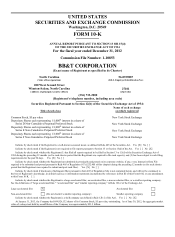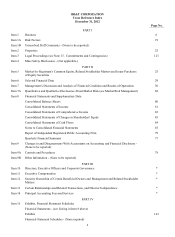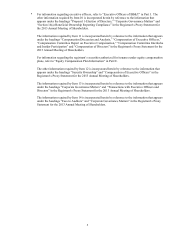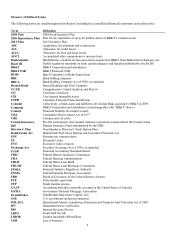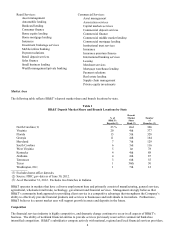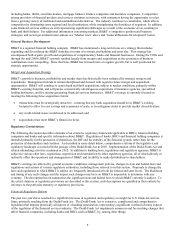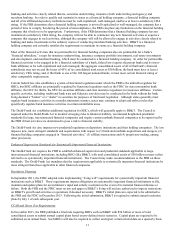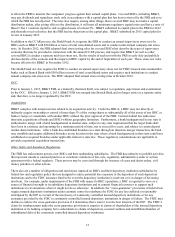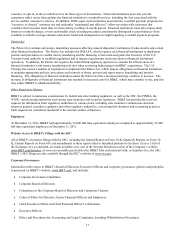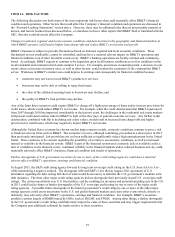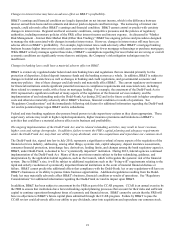BB&T 2012 Annual Report Download - page 33
Download and view the complete annual report
Please find page 33 of the 2012 BB&T annual report below. You can navigate through the pages in the report by either clicking on the pages listed below, or by using the keyword search tool below to find specific information within the annual report.
11
banking and activities closely related thereto, securities underwriting, insurance (both underwriting and agency) and
merchant banking. In order to qualify and maintain its status as a financial holding company, a financial holding company
and all of its affiliated depository institutions must be well-capitalized, well-managed, and have at least a satisfactory CRA
rating. If the FRB determines that a financial holding company is not well-capitalized or well-managed, the company has a
period of time to comply, but during the period of noncompliance, the FRB can place any limitations on the financial holding
company that it believes to be appropriate. Furthermore, if the FRB determines that a financial holding company has not
maintained a satisfactory CRA rating, the company will not be able to commence any new financial activities or acquire a
company that engages in such activities, although the company will still be allowed to engage in activities closely related to
banking and make investments in the ordinary course of conducting merchant banking activities. BB&T is a financial
holding company and currently satisfies the requirements to maintain its status as a financial holding company.
Most of the financial activities that are permissible for financial holding companies also are permissible for a bank’ s
“financial subsidiary,” except for insurance underwriting, insurance company portfolio investments, real estate investments
and development, and merchant banking, which must be conducted in a financial holding company. In order for permissible
financial activities to be engaged in by a financial subsidiary of a bank, federal law requires the parent bank (and its sister-
bank affiliates) to be well-capitalized and well-managed; the aggregate consolidated assets of all of that bank’ s financial
subsidiaries may not exceed the lesser of 45% of its consolidated total assets or $50 billion; the bank must have at least a
satisfactory CRA rating; and, if that bank is one of the 100 largest national banks, it must meet certain financial rating or
other comparable requirements.
Current federal law also establishes a system of functional regulation under which the FRB is the umbrella regulator for
BHCs, but BHC affiliates are principally regulated by functional regulators such as the FDIC for state nonmember bank
affiliates, the OCC for thrifts, the SEC for securities affiliates and state insurance regulators for insurance affiliates. Certain
specific activities, including traditional bank trust and fiduciary activities may be conducted in the bank without the bank
being deemed a “broker” or a “dealer” in securities for purposes of functional regulation. Although states generally must
regulate bank insurance activities in a nondiscriminatory manner, states may continue to adopt and enforce rules that
specifically regulate bank insurance activities in certain identifiable areas.
The Dodd-Frank Act establishes additional regulation for BHCs, which will generally apply to BB&T. The Council is
required under the Dodd-Frank Act to monitor emerging risks to financial stability, recommend heightened prudential
standards for large, interconnected financial companies and require certain nonbank financial companies to be supervised by
the FRB if their activities are determined to pose a risk to financial stability.
The Dodd-Frank Act also imposes new prudential regulation on depository institutions and their holding companies. The law
imposes new, more stringent standards and requirements with respect to (1) bank and nonbank acquisitions and mergers, (2)
financial holding companies engaged in “financial activities,” (3) affiliate transactions and (4) proprietary trading, among
other provisions.
Enhanced Supervision Standards for Systemically Important Financial Institutions
The Dodd-Frank Act requires the FRB to establish enhanced supervision and prudential standards applicable to large,
interconnected financial institutions, including BHCs like BB&T, with total consolidated assets of $50 billion or more (often
referred to as systemically important financial institutions). The Council may make recommendations to the FRB on those
standards. The Dodd-Frank Act mandates that the requirements applicable to systemically important financial institutions be
more stringent than those applicable to other financial companies.
Resolution Planning
In September 2011, the FDIC adopted rules implementing “living will” requirements for systemically important financial
institutions such as BB&T. These requirements impose obligations on systemically important financial institutions to file,
maintain and update plans for an institution’ s rapid and orderly resolution in the event of its material financial distress or
failure. Both the FRB and the FDIC must review and approve BB&T’ s living will and are authorized to impose restrictions
on BB&T’ s growth and activities or operations if deemed necessary. BB&T’ s initial plans are expected to be submitted to
the FRB and the FDIC in December 2013. Following the initial submission, BB&T is required to submit annual resolution
plans by July 1 of each subsequent year.
CCAR and Stress Test Requirements
In November 2011, the FRB published a final rule requiring BHCs such as BB&T with $50 billion or more of total
consolidated assets to submit annual capital plans based on pre-defined stress scenarios. Capital plans are required to be
submitted on an annual basis. Such BHCs will also be required to collect and report certain related data on a quarterly basis


